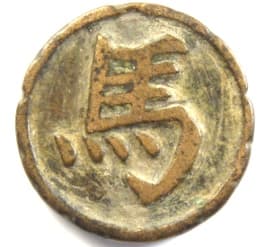Piececlopedia: Mao
Historical notes


The Mao is quite well known as the 'knight' in Xiangqi (aka Chinese Chess), as well as Korean Chess. Its Chinese name of 馬 means horse. It has some popularity as a problem piece, and you can see some examples at the Retrograde Analysis Corner, and on Torsten Linss' problem page.
In Fergus Duniho's Cavalier Chess and Grand Cavalier Chess, this piece is called a Cavalier and is used in place of Pawns.
Movement
The Mao is similar to the chess Knight - it ends up the same distance away, but it can not jump over intervening pieces like the chess Knight. Rather, the Mao is considered to move first one space orthogonally, and then one space diagonally (away from the starting square) to its destination. The intermediate square must be empty.
Note that this makes it possible for the mao to pin pieces, and it is possible for a Mao to attack an opposing Mao without that Mao attacking back.
Movement diagram
In the diagram below, the White mao on d5 can move to all the squares marked with a black circle. It can also capture the Black mao, even though the Black mao can not capture the White one. Also note that the Black king is not in check, but that the Black rook is pinned.
Vocabulary: Pass-Through Space
To reach its destination, a Mao must have an unoccupied pass-through space. This is a space that must be stepped through for a piece to continue moving. Riders and steppers have pass-through spaces, though leapers do not. When a Mao moves, it first makes one step orthogonally, then makes a second step diagonally outward. Its first step takes it to a pass-through space. If this space is occupied, it cannot make any move in that direction. Having this pass-through space is what distinguishes the Mao from the Knight. The Knight leaps to the same spaces a Mao may step to, whether or not any spaces in between are occupied. For a rider, such as a Rook, each space in its path is a pass-through space to the next space. If any space in its path is occupied, it cannot move further.
Images
|
|
||||||||
This is an item in the Piececlopedia: an overview of different (fairy) chess pieces.
Written by Ben Good and Fergus Duniho.
WWW page created: January 15, 1999.
Last Updated: April 11, 2025.

